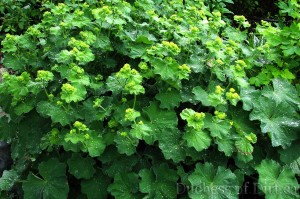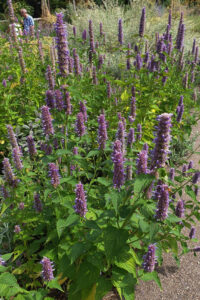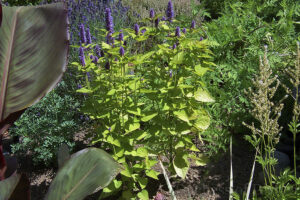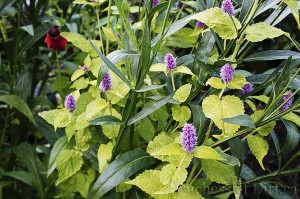Alchemilla mollis
 Alchemilla mollis Family: Rosaceae
Alchemilla mollis Family: Rosaceae
(al-kem-ILL-ah MAWL-iss)
syn. Alchemilla vulgaris
Common name: lady’s mantle
Zone: 3 – 8
Height: 18 – 24 in (45 – 60 cm)
Spread:18 – 24 in (45 – 60 cm)
Aspect: full sun; partial shade
Soil: average
Water: moderate
Description: An herbaceous perennial with good ground-covering foliage that forms a neat mound. Soft, pale grey-green rounded leaves are lobed and have crinkled edges. Airy sprays of tiny greenish-yellow flowers from spring to mid-summer.
Special Notes: Native to Greece, Turkey and Caucasus. The 2 – 4 inch (5 – 10 cm) leaves hold small droplets of water and dew. Good cut flower; dries well for floral arranging. Prolific self-seeder. Cut entire plant back to ground when flowers are spent and before they set seed. Relatively pest and disease free. May get powdery mildew in hot humid climate. Drought tolerant. Propagation by seed; division in spring or autumn.
RHS Award of Garden Merit 1993
Posted on December 17, 2012; updated on August 6, 2024
Agastache rugosa
 Agastache rugosa
Agastache rugosa
(ag-ak-STAK-ee roo-GO-sah)
syn. Lophanthus rugosus
Family: Lamiaceae
Common name: Korean mint; purple giant hyssop
Zone: 5 – 9
Height: 24 – 36 in (60 – 90 cm)
Spread: 24 in (60 cm)
Aspect: full sun; partial shade
Soil: moist; well-draining
Water: regular
Description: An herbaceous perennial with an erect habit. Oval, closely-toothed, medium green leaves are slightly hairy on their underside. Short spikes of lavender-blue flowers appear from mid-summer through to early fall. Small seeds are black.
Special Notes: Native to Korea, Japan, China and Vietnam. Leaves have a strong mint and liquorice scent when rubbed. Ornamental and medicinal plant used for teas, seasoning meats and in Eastern medicine. Perfect dried flower. Attracts bees and butterflies. Relatively few pests and disease problems but watch for powdery mildew. Propagate by seed, by cuttings in early spring or in summer, or by division in early spring or autumn.
In our Zone 7a garden: I have placed a few of these plants in my front bed where they must compete with the roots of my mature Aesculus hippocastanum (European horse chestnut) and Acer saccharinum (silver maple) trees. The soil is not stellar in this area of my garden and I have a hard time getting enough water to the plants. The two trees are famous for sucking all of the benefits out of the soil. Having said that, Agastache rugosa is one plant species that survives in my garden under these tough conditions, despite what the reference sources stipulate are its growing needs. Of course, it is not as lush as if it were provided fertile soil and adequate water but by planting more plants close together I can achieve roughly the same effect as from one plant alone.
Posted on March 13, 2013; updated on August 5, 2024
Agastache foeniculum ‘Golden Jubilee’
 Agastache foeniculum ‘Golden Jubilee’
Agastache foeniculum ‘Golden Jubilee’
(ag-ah-STAK-ee foe-NIK-yew-lum)
Family: Lamiaceae
Common name: golden anise hyssop
Zone: 5 – 9
Height: 24 – 36 in (60 – 90cm)
Spread: 18 – 24 in (45 – 60cm)
Aspect: full sun; partial shade
Soil: average; well-draining
Water: moderate
 Description: An herbaceous perennial with an upright, clump-forming habit. Oval, closely-toothed, golden leaves are slightly hairy on their underside. Short spikes of lavender-purple flowers appear from mid-summer through to early autumn. Small seeds are black.
Description: An herbaceous perennial with an upright, clump-forming habit. Oval, closely-toothed, golden leaves are slightly hairy on their underside. Short spikes of lavender-purple flowers appear from mid-summer through to early autumn. Small seeds are black.
Special Notes: Very first golden-leaved agastache bred by K. Sahin Zaden in Holland. Named in honour of Queen Elizabeth II celebrating her 50th year reign – her Golden Jubilee. Leaves have a pleasing anise scent when rubbed. Great for tea. Seeds may be used in baking. Perfect dried flower. Attracts bees and butterflies. Relatively few pests and disease problems but watch for powdery mildew. Propagate by seed, by cuttings in early spring or in summer, or by division in early spring or autumn. Will self-sow.
Posted on April 28, 2013; updated on August 5, 2024


